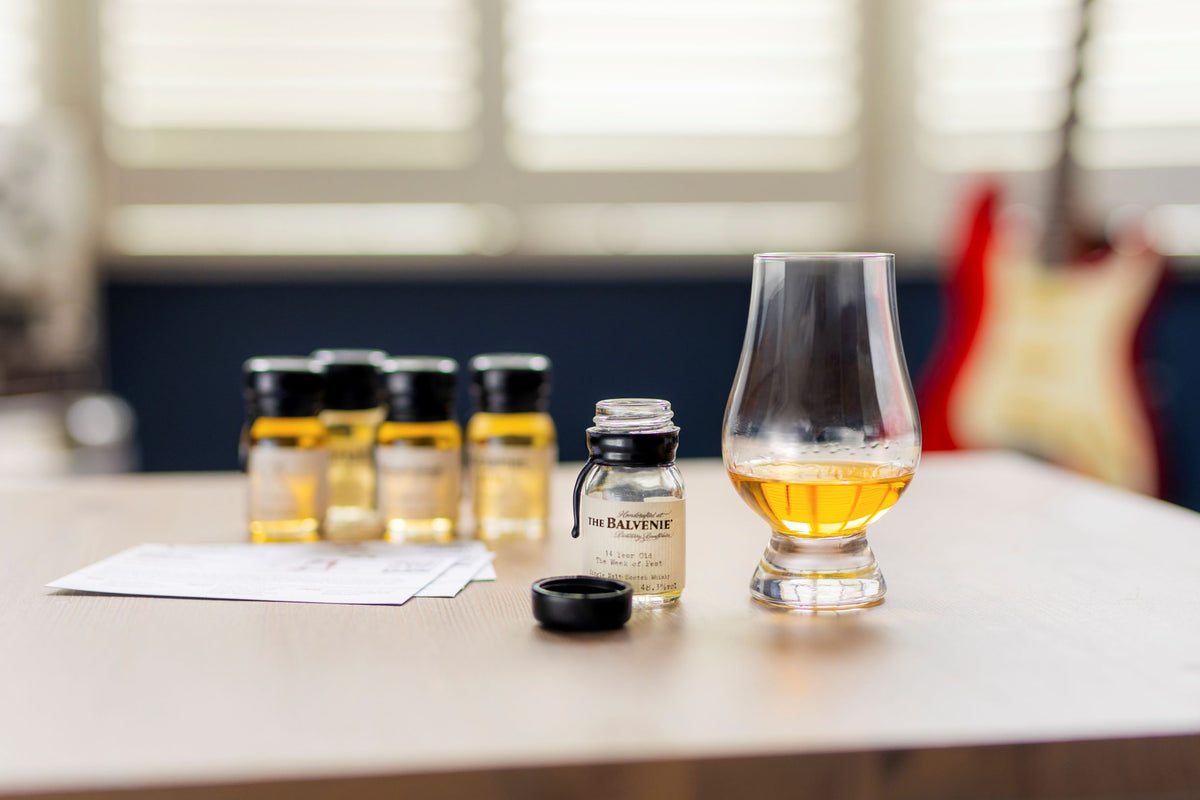How to taste whisky

You’ve got your Pour & Sip set – great! Here’s how to get the most out of your tasters when it comes to nose, palate, and finish.
Let’s talk about tasting notes. Sometimes an elaborate list of increasingly obscure flavour references only serves to muddy the water. How is anyone supposed to know what someone else’s grandma’s signature cake tasted like? But often, a well-crafted note accurately communicates the character of a whisky, and can give vital clues as to how that spirit was produced, too.
That’s all well and good, but what if your whisky smells like… whisky? And tastes like… whisky? Sure, some are fruitier than others. Some are smokier. But it’s not always easy to pick out individual aromas and flavours. And that’s ok! Whisky is made to be enjoyed, relished, savoured.
If that’s where you are, fantastic. Play on! Team Pour & Sip gives you permission to appreciate whisky, enjoy life, and have a good time. But if you want to try and delve a little deeper into your dram, find some of those more specific aromas and flavours, read on. Here’s a handy guide to how to nose and taste your spirit.
We’ve broken this up into appearance, nose, palate and finish. We’ve got top tips in each section, what to look out for, and what to try if it’s all proving as clear as mud. And remember – the most important thing about whisky is to enjoy it. We don’t taste whisky in this way all the time. This is reserved for those occasions when you really want to get to know a dram.
Things you’ll need (or not)
Tasting whisky is much easier if you’ve got the right glassware. The best kind are tapered towards the top, like a Glencairn Tasting Glass.
Also, keep some water to hand for sipping and diluting. We’ll get on to why shortly.
Give yourself a head start and try to eliminate distracting aromas in your environment. Eschew the scented candles, don’t try and write tasting notes while you’ve got a tasty dinner in the oven, or after you’ve eaten some garlic bread! Neutrality is your friend.
A note on ice: it’s totally fine to add ice if you’re sipping for pure enjoyment. But the cold will make it harder for you to get at those all-important aromas. Keep it at room temperature!
If you’re tasting lots of different whiskies, it can be useful to keep a spittoon nearby. Not overindulging will keep both your palate and mind fresh!
One last point – a lot of what we perceive as flavour is actually aroma. Our tongue is a pretty simple thing when it comes to the flavours it can pick out: sweet, salt, sour, bitter and umami (and you won’t get salt in a whisky, anyway). That rest is thanks to our olfactory bulb, which sits up behind the nose. It’s this that detects all the complexity of aroma (and by extension, flavour). This is why you can’t taste anything if you’ve got a cold!
With that out of the way, let’s do this!
Appearance
How a whisky looks doesn’t always tell us a lot about the spirit. But it’s always worth taking a look at the colour of your whisky. Is it pale or bright? Is it straw, gold, amber, or even brown? The colour and intensity can tell you how long a whisky might have spent in a cask, what the cask previously held before the spirit that became your whisky went into it, and even how many times the cask itself might have been used. Or the hue could be from a dose of caramel colour, sometimes known as E150. A lot of producers use this to ensure colour consistency across bottles.
Nose
Now is the time to wake up your nose! Pro tip: don’t stick your nose straight into the glass. This is a high-strength spirit and it might burn. Similarly, don’t shake the whisky round in the glass. This works for wine, but do it to a spirit and you’ll just send all the alcohol aromas shooting towards your nose. We want to explore all the other things going on in the glass! Instead, roll it gently around. Approach it slowly – smell it from a distance and gradually get closer. Yes, you can probably smell alcohol. But what else? Is it grassy? Sweet? Fruity? Grainy? What about spicy, or floral, or woody notes? Is there any smoke in there? See if you can settle on two or three of these, then think: what spices? Or what flowers? If it’s sweet, is it like dessert or confectionery? If you can smell a fruity aroma is it like fresh apples or dried raisins? There are no wrong answers. Explore and have fun!
It can really help to add some water here. There’s no shame in adding water to whisky, especially when writing tasting notes! But perhaps have a taste of the spirit neat, and then go back and repeat the above with the addition of water. How much is up to you – start with a few drops and add more until you notice the difference. Caution advised – you can add more water in, but you can’t take it out!
Palate
Enough messing about – it’s time for a taste! The best approach is to take a little sip, smaller than you’d imagine sensible, then take another one, and then see what flavours you get. Run through the same broad flavour groups as you did on the nose. Pick your two or three and hone in again. There shouldn’t be a huge difference between the nose and the palate – but some of the flavours might be more or less pronounced. Note down these differences, it all helps to build up a picture of the whisky and its character.
It’s also important to consider our sense of touch when it comes to tasting whisky. A spirit’s mouthfeel can tell us a lot about its character. Is it prickly or smooth? Is it velvety and mouth-coating? Thin? Spiky? And is the sensation pleasant or not? Take a glance at the ABV – a spirit with a higher alcohol content is likely to feel ‘warmer’, but this doesn’t have to detract from how enjoyable it is.
Finish
The finish of a whisky refers to the flavours and sensations that are left in your mouth once you’ve swallowed it (or perhaps used a spittoon). And it’s good to focus on the positive points, here. Again, what flavours can you get? Is there a continuation of the palate, or has something new appeared? How long do these flavours last for? Are they gone in seconds? A minute? Longer? Again, think about the feel – is there a lingering warmth or prickle? There’s a lot going on in the finish of a whisky.
Ta-da! You’ve tasted a whisky! Look back at what you’ve noticed. You’ve put together a pretty comprehensive tasting note!
Still finding it tricky? If your nose feels ‘dead’, try sniffing your own clean skin, or even some coffee beans (if you have them to hand), as a bit of a reset. Palate feeling overwhelmed? Have a nibble on a plain cracker. Then go back. Take some time. And don’t worry. Like any other skill, whisky tasting takes practice. Try comparing two or more samples to see where the differences are. And trust your own nose and palate! There are no wrong answers here.
Ultimately, whisky is about enjoyment. Who cares if you can’t write a fancy tasting note? Just savour it and have fun. And don’t forget to share your tasting notes with us using #pourandsip on Twitter and Instagram!



